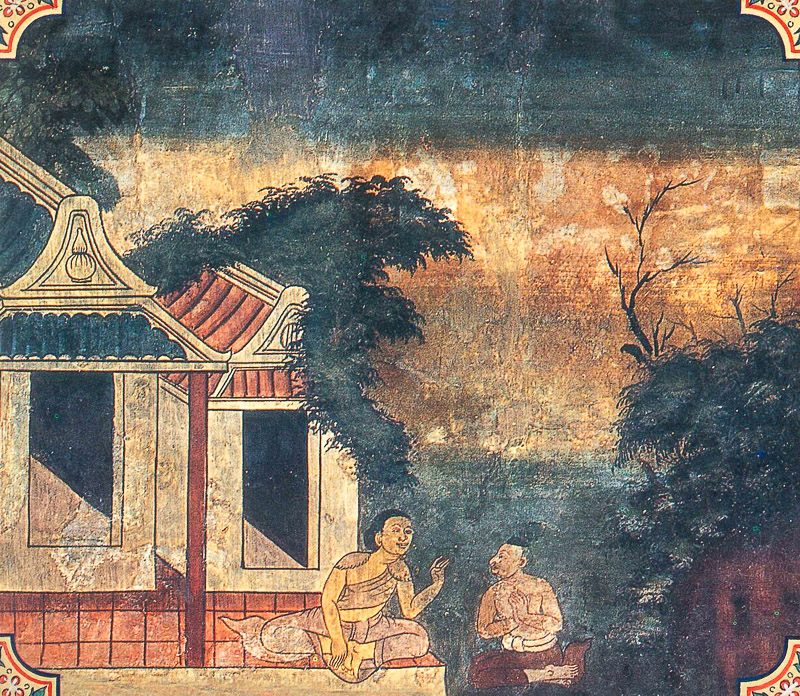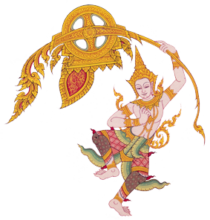
The Bodhisatta was once a teacher, famed across the land. Long before this, there was a virtuous monk in a village who was supported by a wealthy landowner. One day an arahant arrived in the village, and the landowner was so impressed by his demeanor and his teaching that he asked him to stay at the local monastery so they could talk further. The village monk worried that his patron would begin supporting the arahant instead of himself and schemed to make sure this did not happen.
The next morning, the village monk was supposed to accompany the arahant to the landowner’s house, but he rang the gong with the back of his fingernail so the arahant would not hear it and went to see the landowner alone. He told his sponsor that the arahant had ignored his wake-up call and suggested he did not want to return because the food served the day before was not fancy enough. Assuming, instead, that the arahant must have been weary from his journey, the landowner asked the village monk to take him a bowl of delicious food. Still acting with a jealous heart, the monk discarded the food instead of delivering it. He was immediately racked with remorse, fell ill, and died soon after.
The monk suffered hundreds of thousands of years of damnation in hell before being reborn for five hundred lives as an ogre who never found enough food to eat, five hundred more as an eternally hungry dog, and then as a starving child named Mittavindaka in a beggar family. His mother and father, tormented by the perpetual hunger pangs that had struck them every day since the boy had been born, knew Mittavindaka had cursed them and cast him out of their village.
Now homeless, Mittavindaka wandered aimlessly and ended up in the city where the Bodhisatta was teaching. He was taken in as a charity scholar in the Bodhisatta’s school, but he often fought with other students and disrespected the Bodhisatta. It wasn’t long before Mittavindaka ran away to a remote village and worked as a laborer. He married a poor woman, had two children with her, and eventually the villagers hired him to teach them about the true doctrine. But hardship plagued the village—the king punished it seven times, it burned to the ground seven times, and the water supply dried up seven times. When the villagers realized all this misfortune had begun after Mittavindaka came to live there, they beat him and drove him away.
Mittavindaka ended up in a haunted forest where demons ate his family. He took to wandering again and found work on a ship. On his seventh day at sea, the winds died and the ship wouldn’t move. The crew cast lots to see who had cursed them, and when Mittavindaka drew the lot seven times straight, he was set afloat on a bamboo raft. As soon as he was overboard, the ship began to sail again.
Mittavindaka’s raft drifted to an island where four female spirits (specifically vimana petas, ghosts whose blissful lives are regularly interrupted by hell-like tortures) lived in a crystal palace, and he stayed with them for seven happy days until they needed to leave for a week of penance. Next, he encountered eight more such spirits in a silver palace, then sixteen in a jewel palace, and finally thirty-two in a gold palace; and he always left when the spirits did.
Then Mittavindaka reached a city of ogres. One of them walked around in the form of a goat. Not knowing her true form, Mittavindaka grabbed the goat by its leg, intending to eat it. In anger, the ogress hurled him across the ocean and he landed in the dry moat around the Bodhisatta’s city. A herd of the king’s goats was grazing in the moat, and Mittavindaka figured if one goat could throw him all the way here, perhaps another could throw him back to one of the islands. He grabbed a goat by the leg, and when it bleated loudly, the goatherders, hiding nearby waiting to catch thieves, ran out and seized him. They beat Mittavindaka and started to haul him away to the king.
While walking out of the city to go bathe, the Bodhisatta saw his former student in bonds. When the goatherders explained why they had seized him, the Bodhisatta asked if he could take Mittavindaka as a slave. They agreed. The Bodhisatta asked Mittavindaka what he had been up to these many years. Upon hearing the story, the Bodhisatta told Mittavindaka that had he been less stubborn and accepted his help at the time, he could have avoided all that misery.
In the Lifetime of the Buddha
An elder disciple of the Buddha named Losaka Tissa was eternally unlucky and never got enough food. On the day he was conceived, all the fishermen of his village failed to catch even a single fish, and while he was in the womb, the village was destroyed by fire seven times and ravaged by the king seven times. The village’s misfortune continued until people figured out which family was the source of the curse (by dividing into two bands and seeing which group was dogged by ruin, then dividing that group, and so on) and drove them out. After Losaka was born, his mother raised him just long enough until he could be sent out as a beggar, and then she left.
When Losaka was seven years old, Sariputta, one of the Buddha’s top disciples, saw the dirty child picking up grains of rice tossed in the street after the pots had been washed. When he heard Losaka’s story, Sariputta invited him to become a novice. He readily agreed and later became a full disciple. But his bad luck continued, even after becoming an arahant, and he rarely got a full helping of food on his alms rounds, receiving just enough for basic sustenance. People were not intentionally cruel to him, but a magic power made a single ladle of rice appear to fill his alms bowl to the brim—seeing this, nobody else gave him more.
When it was Losaka’s last day on earth, Sariputta sensed it and decided that he should finally get to eat a full meal. Sariputta had Losaka accompany him on the morning alms round, but due to Losaka’s bad luck, they both received nothing. So he sent Losaka back to the monastery and collected food on his own. When Sariputta returned, he sent some food to Losaka, but the person who was supposed to deliver it forgot and ate it himself. That afternoon, Sariputta asked Losaka if he had enjoyed his meal, and Losaka said no food had arrived. By this time, it was afternoon and too late for disciples to eat a meal. So Sariputta went to the palace and asked the king to fill his bowl with honey, ghee, butter, and sugar, which disciples can eat at any time. He returned with the food and held the bowl himself while Losaka ate so that there could be no mishaps, and finally Losaka ate until he was satisfied. Not long after that, he passed into nirvana.
Mittavindaka was an earlier birth of Losaka Tissa. The Buddha told this story to explain to the other disciples why Losaka had such incredible misfortune in his life yet was able to achieve arahantship.
